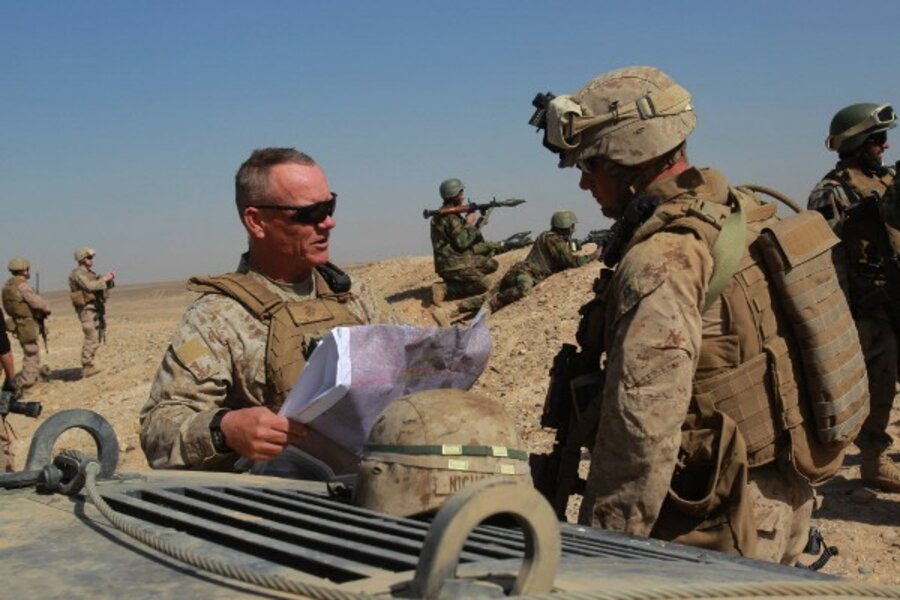In Marjah, Afghanistan, allied offensive going well so far
Loading...
| Washington
The US and Afghan operations in southern Afghanistan are turning a corner, marking “the end of the beginning,” but it’s far too soon to declare victory there, according to the top commander of the region.
Now in its sixth day, the operation in central Helmand province, billed as the largest against the Taliban since 2001, and the first test of President Obama’s new strategy, is going smoothly. But it will take another month before all areas around Marjah and another area, Nad-e-Ali, are secure and another three months before coalition forces can be sure that the Afghan population actually feels safe.
“I guess looking downstream in three months time or thereabouts, we should have a pretty fair idea of whether we’ve been successful,” said Maj. Gen. Nick Carter, the British commander of what is known as Regional Command South, in a video teleconference with reporters at the Pentagon. “But I would be very cautious about triumphalism just yet.”
Next step will be Kandahar province
Only when US and Afghan officials believe they have completed the mission in central Helmand can they take the next step in the new strategy, mounting another major operation in nearby Kandahar province.
American officials have been publicizing this offensive, known as Operation Moshtarak, a Dari word for together, for weeks in hopes of scaring off an enemy before the fighting began. And in many ways, the operation differs in size, scope and method from others: including some 4,000 US Marines and British forces and as many as 7,000 Afghan national security forces. Unlike some other operations over the years, it was given final blessing by Afghan President Hamid Karzai last Friday.
Military officials have estimated that there could be as many as 1,000 Taliban fighters in the region. But it remains unclear if that was an accurate number or if it is, how many fighters have already left the battlefield. That will take some time, a senior military official says.
Offensive focuses on civilian population
Normalcy must be restored for the local population, markets must open, and jobs must reappear. Until then, it’s hard to see how much of the enemy has been diminished under a strategy that focuses more on the civilian population than on killing combatants.
“You see the degradation, but you don’t see it immediately,” says the senior military official, who would speak only on background.
Military officials say the enemy’s attacks have been somewhat more complex than usual, reflecting enemy resolve not to cede ground in the verdant Helmand river valley where much of the country’s opium crop is grown.
The senior military official said coalition forces have encountered more than 50 roadside bombs and some co-called daisy chains, bombs linked to one another to create a series of explosions.
News reports suggest the Taliban may also be using more small arms fire against US, Afghan, and British forces. As the Taliban feels increasingly more pressure, it will be even less inclined to stand and fight coalition forces and will likely turn to more such “asymmetric” tactics, such as roadside and suicide bombs, Maj. Gen. Carter said.
But in many ways, the easy part is nearing an end and the harder slog is still ahead. In the “clear-hold-build” counterinsurgency strategy under Mr. Obama and his top military commander in Afghanistan, Gen. Stanley McChrystal, the “hold” phase – sustaining security – is much more difficult.
Major test for Obama's strategy
“The Marjah offensive will test the president’s new strategy and show whether a population-centered strategy can work,” said Tony Cordesman, a senior fellow at the Center for Strategic and International Studies, a think tank in Washington, in a prepared analysis of the issue. “At the same time, this means that ‘winning’ involves far more than tactical victory, and that the aftermath of the fighting will be much more important than the immediate outcome of the battle.”
This hold phase will be enabled in part by Obama’s additional 30,000 troops. But the strategy will also lean heavily on the Afghan forces, who officials say are so far “performing well.”
Indeed, US officials say where this operation differs from others is that they will have the Afghan and coalition forces to conduct the second holding phase – meaning to secure an area and then sustain that security. Carter said about 1,000 more police officers are being trained and will be sent into Helmand in coming weeks.
-----
Follow us on Twitter.





